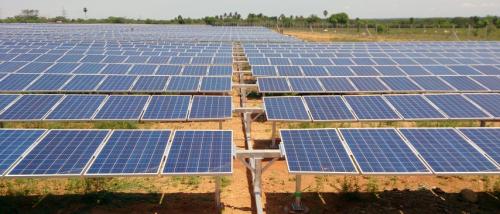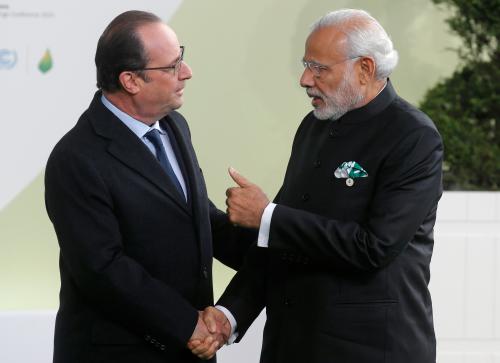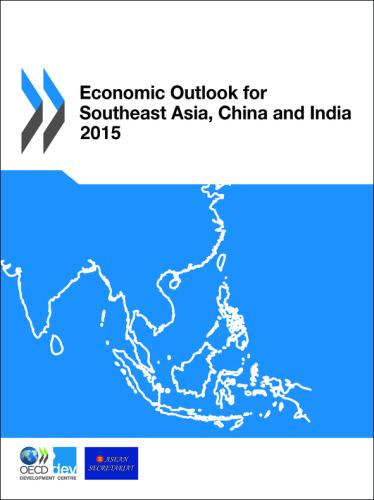Content from the Brookings Institution India Center is now archived. After seven years of an impactful partnership, as of September 11, 2020, Brookings India is now the Centre for Social and Economic Progress, an independent public policy institution based in India.
After the November 2014 joint U.S.-China announcement on climate change, all eyes turned towards India. What would India do? Would it sign a similar agreement, especially with the impending visit by President Barack Obama? Even if some agreement were signed, what would India promise?
Probably one of the best outcomes of the U.S.-China announcement was a de-coupling of India and China. There is no longer (and never really was) a “Chindia”, which portions of the US press periodically blamed for global woes on climate and periodic surges in commodity prices. China and India are rather different, and recognizing the differences helps understand what would make sense from India’s perspective. China has already achieved over 98 percent electrification of homes, while India has at least a third of the population remaining (let alone the shortfalls of supply, leading to almost daily outages). China has had visible air pollution, and wants to move towards green power not just due to carbon, but other pollution as well. Also, given the U.S. is already party to some targets with the U.S.-China declaration, does a second joint declaration with India make sense?
The December 2014 Lima declarations, with Intended Nationally Determined Contributions (INDC), really gave what many developing countries like India were asking for: no top-down obligations. But the flip side is they now have to come up with their plans and commitments.
A new path forward – emitting to develop and improve
Developing countries often mention historical carbon emissions of the developed world, given the cumulative nature of carbon emissions (the half-life of carbon in the atmosphere is almost a century). Thus, instead of annual emissions, some in India and other developing regions want to use cumulative emissions as a metric. Additionally, in terms of per-capita emissions India is meaningfully lower than China and far lower than the United States.
Even assuming that India isn’t to blame for the global climate change scenario, it has a key role to play for the future. What then? India has routinely held that it cannot sacrifice its development by restrictions on energy consumption.
Here the famous Kuznet’s Curve (an upside down smiley) is relevant. It posits that as countries become richer, pollution increases, and then when they are rich enough, pollution comes down. Is it possible to swap the axes, and thus the mindset? Instead of starting with the premise that for a country to develop it has to emit, can we reframe it that emissions will occur whether there is development or not. Then the question becomes what to do with such emissions?
Thus, for India the issue might be not just how much it emits cumulatively, but how well off its people are on a measure of human development? If India develops more, it will have a right to emit slightly more, but such development must be done with far less emissions. And if it develops less, it must emit less, else it has squandered carbon.
Of course, geographic, climate, cultural, legacy, and other differences prevent an easy comparison between countries, but each country can use such a yardstick to figure out how much is enough or required. This is where India can benefit. Given India’s development is occurring well after the US’s development (or even China’s), as well as the cumulative nature of emissions, its relatively delayed development might be a blessing in disguise since in the future, technologies for reduced carbon emissions will be much cheaper.
India’s chosen action plans, and global support
India has already taken actions on its own, in addition to the required INDC calculations. These include a very, very ambitious target for renewable energy, with a ~62% compound annual growth rate for solar power, to grow to 100,000 MW by 2022. This is especially stunning given that today the total capacity is only some 250,000 MW of electricity. Second, a number of states have announced low carbon roadmaps, action plans, or at least carried out analysis.
The US can contribute by helping states with funding and building human capacity. There can be city-to-city engagements, especially to learn new ideas and best practices (e.g., Los Angeles has made dramatic strides to reduce its carbon footprint). However, there is one difference between US efforts and Indian efforts at de-carbonizing. The US mostly has gradual changes or retrofits to consider, while India’s population is still growing, with attendant urbanization and sectoral shifts in the economy. India thus represents a new and large market for US and global technology providers. To accelerate de-carbonization, India would benefit from state-of-the-art technologies at reasonable terms.
India also needs financing support, not money per se, but cheaper financing. One reason India’s renewable energy (RE) power appears more expensive than some other countries is the high cost of capital; funding for RE projects in the U.S. is often at half the rate, and Abu Dhabi has funded their projects at around a quarter of Indian rates.
Lastly, India must improve the future energy mix towards lower-carbon options. On the supply side nuclear power is an option to consider. It has already acknowledged that its domestic three-phase plan will not suffice for its energy ambitions. India is now open to global technology, fuel, and capital, but many details (especially on liability, technology transfer, and financing) need to be worked out.
On the demand side, vehicular emissions (of local air pollutants and not just carbon) are a concern for India. This is where new technologies, including for electric vehicles, will be very important. Such a focus can synergize not just development and carbon concerns, but also align with India’s desire to reduce petroleum import dependencies.
Aligning the desirable with feasible
Climate discussions are often mired in complexity if not acrimony. Negotiations are the art of balancing the feasible and the desirable. First and foremost, no targets or goals will work if they cannot be achieved. It was easy for China to make some of its promise in part because they are already far along the energy and development curve, and in part because its population growth rate is minimal (a few percent at most projected over 30 years). In the same period, India’s population is projected to grow by 38%. The U.S. also has population growth rate projected, partly due to immigration, but the current per capita emissions (baseline) are at a very high rate, from which productivity and efficiency gains can suffice, especially given the high development and GDP. In contrast, India cannot ask people in the dark to cut down their emissions.
Just as one cannot determine the demand for a product without knowing its price, “feasible” also depends on the cost and effort. That is what translates to the desirable part. India actually wants to do a lot towards climate change – it just has to be multi-dimensionally attractive. It’s not clear if India wants the privilege of its own climate treaty. More than a new US-India climate deal, the US can encourage and help India achieve an ambitious INDC. This would strengthen the multi-lateral framework for Paris, and also encourage other nations to similarly be proactive in setting ambitious yet achievable targets. If some want a bilateral treaty for an emission reduction commitment, India could do so, but many targets are symbolic. India can make any agreement, but its actions should speak louder than its words.










